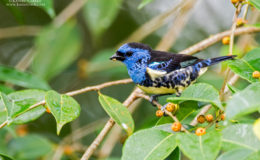
Birdwatchers
The Yellow-headed Cara-cara is one of the most commonly seen birds of prey in South American cities.

The Yellow-headed Cara-cara is one of the most commonly seen birds of prey in South American cities.

The Red-capped Cardinal gets its name from its crimson head. Immature birds have a brown head.

The Turquoise Tanager is mainly dark blue, with turquoise edging to the longest wing feathers and a yellowish lower underparts.


The Great Horned Owl is the most common owl in the Americas, and is recognizable by feather tufts on its head.

The Black Nunbird is glossy blue-black with white-grey edges on its wings and a bright orange-red beak, and belongs to the family of birds known as puffbirds.

The Orange-winged Amazon is a very popular pet parrot. In the wild, they live communally in preferred palm trees where they can been seen in numbers at dawn and dusk.

The Peregrine Falcon is best known for its speed, reaching over 320 km/h during its high speed dive during hunts, making it the fastest animal on earth.


Waking up at 4 am to get to remote locations before sunrise might not be your idea of fun, but for local wildlife photographer, Kester Clarke, it’s a great way to spend his weekends.

The Gray Kingbird is a large flycatcher with a black face mask, gray upperparts and mostly white underparts.

The Festive Amazon, also known as the Festive Parrot, is very similar to other Amazona parrots, but can be distinguished by their dark reddish lores and eyebrow.

Male Black Manakins are glossy blue-black, while females are yellow-olive in colour.

he Green Honeycreeper is a forest canopy species but it often descends along forest edges and clearings to take fruit and sometimes nectar.

Pompadour Cotinga are often found in canopy and near forest edges where they feed on fruit only, preferring figs.

The Crimson Topaz is among the largest of all hummingbirds, second only to the Giant Hummingbird found in the Andes.

The King Vulture (Sarcoramphus papa) is large and predominantly white with a grayish-black flight and tail feathers.

The Variable Chachalaca, formerly Little Chachalaca, is often found near clearings and forest patches with dense undergrowth where it feeds on fruit and berries both on the ground and in the trees.

The Red-breasted Meadowlark, formerly known as the Red-breasted Blackbird, is common near rice cultivations and countrysides here.

White-chested Emerald hummingbirds feed on nectar from the flowers of trees and smaller plants.
The ePaper edition, on the Web & in stores for Android, iPhone & iPad.
Included free with your web subscription. Learn more.